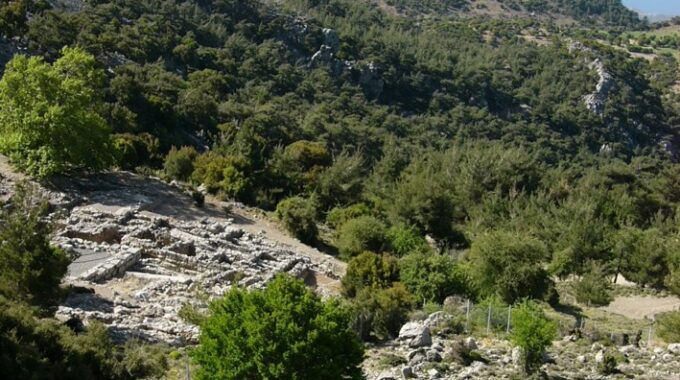Excavations at the Sanctuary of Hermes and Aphrodite at Syme Viannou began in 1972 under the direction of Angeliki Lebessi and continued until 2003. The sanctuary was founded high up on a slope of the Dikte mountains in central Crete facing the Libyan Sea. It operated continuously, even if with variations in the intensity of the cult from one period to another, and most importantly in the type of rituals, from about 2000 BC until the 7th century AD. Within an area of 17,000m2, of which about 3,500m have been investigated, and over a period of about 27 centuries, at least 14 different architectural phases have been identified. The evidence shows that the evolution of the sanctuary closely followed the political, economic, and social developments of the island. In the Minoan period, two elaborate Old-Palatial, multi-roomed, successive structures were built, whereas in Neopalatial times, the sacred space underwent a radical transformation with the construction of monumental open-air arrangements, including an immense sacred enclosure with a large stone-built podium in its center, surrounded by a winding, paved sacred road, that follows the sloping terrain. In the Iron Age, we can follow the history of the site through the construction of an altar and three extensive, stepped terraces built around it in the Late Geometric/Early Archaic periods, and later, in the Hellenistic and Roman periods, through the erection of an oikos-temple near the spring that still flows at the site.
Although in a remote, mountainous area, the Syme Sanctuary retained for centuries an almost unparalleled prominence, which can only be understood in association with the importance of the rituals that were performed at the site. These rituals left deep traces in the black, greasy layers that contain abundant remains of animal sacrifices, libations and ritual feasting. Numerous offerings of clay, stone, and metal, which belong to a wide range of types and dates stretching from the Minoan to the Roman period, were found mixed in these disturbed layers: ceramics by the thousands, stone vases and vessels by the hundreds, a multitude of bronze and clay human and animal figurines, and many votive offerings made of bronze sheet in various types, allow us to examine the cult practices in this sanctuary, the identity of the deities and the character of their worship, and the aspirations of the votaries. At least from the early 1st millennium BC, young Cretans, male and female, from various cities of Eastern and Central Crete in particular, came to the Sanctuary of Syme to celebrate their coming-of-age in the context of their education as perfect citizens, placing themselves under the protection of the divine couple of Hermes and Aphrodite.

